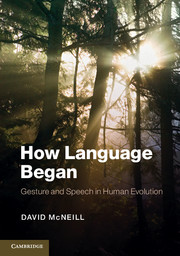Book contents
- Frontmatter
- Contents
- List of figures
- List of tables
- Preface – Out on a limb
- Acknowledgments
- 1 INTRODUCTION – GESTURE AND THE ORIGIN OF LANGUAGE
- 2 What evolved (in part) – the growth point
- 3 How it evolved (in part) – Mead's Loop
- 4 Effects of Mead's Loop
- 5 Ontogenesis in evolution – evolution in ontogenesis
- 6 Alternatives, their limits, and the science base of the growth point
- Notes
- References
- Index
3 - How it evolved (in part) – Mead's Loop
Published online by Cambridge University Press: 05 October 2012
- Frontmatter
- Contents
- List of figures
- List of tables
- Preface – Out on a limb
- Acknowledgments
- 1 INTRODUCTION – GESTURE AND THE ORIGIN OF LANGUAGE
- 2 What evolved (in part) – the growth point
- 3 How it evolved (in part) – Mead's Loop
- 4 Effects of Mead's Loop
- 5 Ontogenesis in evolution – evolution in ontogenesis
- 6 Alternatives, their limits, and the science base of the growth point
- Notes
- References
- Index
Summary
CHAPTER PLAN
Here begins our main topic. Now that we have an idea of what evolved, we can consider explanations of how it came about.
The sources of language dynamics sketched earlier are: (1) the imagery–language dialectic within each GP; (2) the incorporation of contexts into psychological predicates as GPs; (3) the further meanings and contexts generated in unpacking the GP; and (4) the larger-scale purposes and cultural beliefs and practices encompassed metapragmatically. The GP model applies at the intersection of the dynamic and static – and is itself the dynamic dimension's minimal Vygotskian unit.
The exposition in this chapter is straightforward. I start with a currently popular theory, “gesture-first,” and explain what it is and what is wrong with it, that it does not predict (and could not have led to) this dynamic dimension. Then I introduce an alternative, called “Mead’s Loop,” and explain it in detail, including how it could have been naturally selected and the changes it would have caused in mind and brain. I take up next the origin of syntax as explicated by Mead’s Loop and the brain model it suggests, including the forging in the evolving brain of a specific thought– language–hand link, and end with a proposed time-line for the beginning of language.
Information
- Type
- Chapter
- Information
- How Language BeganGesture and Speech in Human Evolution, pp. 58 - 113Publisher: Cambridge University PressPrint publication year: 2012
